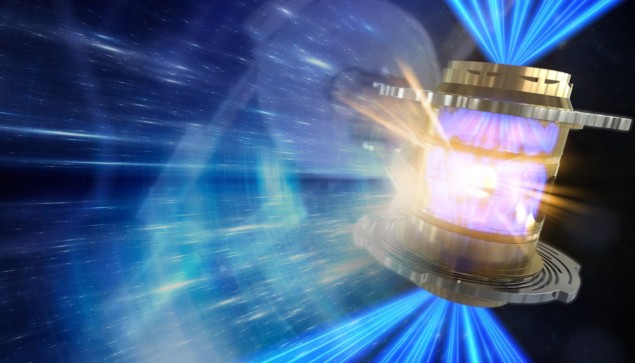Anomalous plasma burning heats-up fusion research
24 Nov 2022
Suprathermal effect: researchers at NIF have discovered that ions involved in nuclear fusion are not moving as expected. (Courtesy: John Jett/Jake Long/LLNL)
Last year and after about a decade of trying, physicists working at the mammoth National Ignition Facility (NIF) in the US finally succeeded in generating a self-sustaining fusion reaction. But having since struggled to reproduce the feat, they have been busy trying to work out what makes the results of their experiments so variable. Now, a new finding at NIF may provide a clue – ions in what is known as a burning plasma have an unexpected kinetic energy distribution, which encourages fusion.
The $3.5bn NIF at the Lawrence Livermore National Laboratory in California was designed to recreate the conditions inside nuclear warheads, with the primary aim of maintaining the US weapons stockpile without testing. The facility is also used to develop a new clean, abundant source of fusion energy. It does so by firing exceptionally powerful laser pulses at a 1 cm-long hollow metal cylinder. This generates X-rays that then irradiate a peppercorn-sized capsule at the cylinder’s centre made from industrial diamond and containing the hydrogen isotopes deuterium and tritium. With some of the diamond blasted off, the capsule rapidly implodes and for a fraction of a second creates a plasma with the extreme temperatures and pressures needed to fuse the light nuclei together – yielding alpha particles, neutrons and excess energy.
Since NIF switched on in 2009, scientists have struggled to produce significant fusion yields – getting nowhere close to generating more energy than is needed to power the laser. But in early 2021 they had good news, reporting the observation of a burning plasma in which the alpha particles are the main source of heat for the plasma. This was followed by an even more eye-grabbing result in August last year: the ignition of the plasma. In this case the alpha-particle heating was enough to outstrip all energy losses within the plasma and enabled a whopping 1.37 MJ output. This is more than 70% of the1.92 MJ delivered by the laser and about eight times as much as their previous best shot.
Researchers then tried to reproduce that result but another four shots in the following few months yielded at best about half of the record-breaking output. They had better luck in September this year when they achieved about 1.2 MJ from a 2.08 MJ laser pulse. This greater input allowed them to use a thicker capsule, which was less sensitive to the problem plaguing the previous shots – tiny defects in the diamond that can cause carbon to enter the fusion “hot spot” and cool the reactions.
Surprising kinetic distribution
Now, new work by Edward Hartouni of Lawrence Livermore and colleagues in the US and UK could shed light on NIF’s inconsistent performance when it comes to fusion. They found that the kinetic energy of the reacting deuterium–tritium ion pairs in NIF’s burning plasma does not follow the expected Maxwell–Boltzmann distribution that is characteristic of thermal plasmas.
The researchers measured the ions’ properties by carrying out spectroscopy of the neutrons produced alongside the alpha particles. Although the neutrons are emitted at a single energy in all directions within the reference frame of the fusing nuclei, seen from the lab they are jostled around by thermal fluctuations and the plasma’s bulk motion. This means that the energy spectrum of the emitted neutrons provides information about the behaviour of the ions.
Hartouni and colleagues collected isotropic neutron data using five time-of-flight spectrometers positioned at different points around the fusion target. After plotting the results, they were able to work out the ions’ mean velocity – and hence kinetic energy – by measuring the offset between the neutrons’ spectral peak and the energy they are known to acquire in deuterium–tritium fusion reactions. In a similar way, they calculated the temperature of the ions.
Steeper slope
The researchers analysed the results from numerous implosion experiments at NIF by plotting them all on a graph of ion velocity against temperature. Doing so, they found that the data points clustered together in two distinct groups. Within the bounds of experimental error, those shots with a lower fusion output followed the gently diminishing slope characteristic of thermal plasmas. Whereas the shots yielding higher fusion energies instead veered off at a steeper angle.READ MORE

The output of the latter shots in fact corresponded to ion temperatures matching the shots’ ion velocity rather than their measured (lower) ion temperatures. The researchers say that the ions could have a “suprathermal energy spectrum”, and that more of them have energies favourable for fusion reactions than would be the case for a thermal plasma.
Hartouni and colleagues have still to establish what is causing this departure from a Maxwell–Boltzmann distribution. They point to several potential explanations, but each has its shortcomings. For example, they suggest that there may be fewer neutrons from beyond the hot spot reaching their detectors than those emitted on the near side. This would tend to artificially inflate the mean neutron energy. But they say that other diagnostic observations imply that the hot spot is not dense enough to explain this effect. Likewise, they conclude that measurement distortions due to a spatial offset between the hotspot and capsule centre can be ruled out because X-ray images of the plasma show no such offset.
The researchers say they are continuing to carry out experiments, revise theory and perform computer simulations to try and pin down the cause of the anomaly. If they are successful, according to Stefano Atzeni of the University of Rome “La Sapienza”, they might be in a better position to control NIF’s fusion reactions so that it becomes possible to achieve ignition on demand. “More accurate models of basic physical processes make simulation more predictive,” he says.
The research is described in Nature.
Edwin Cartlidge is a science writer based in Rome
from physicsworld.com 29/11/2022

Δεν υπάρχουν σχόλια:
Δημοσίευση σχολίου